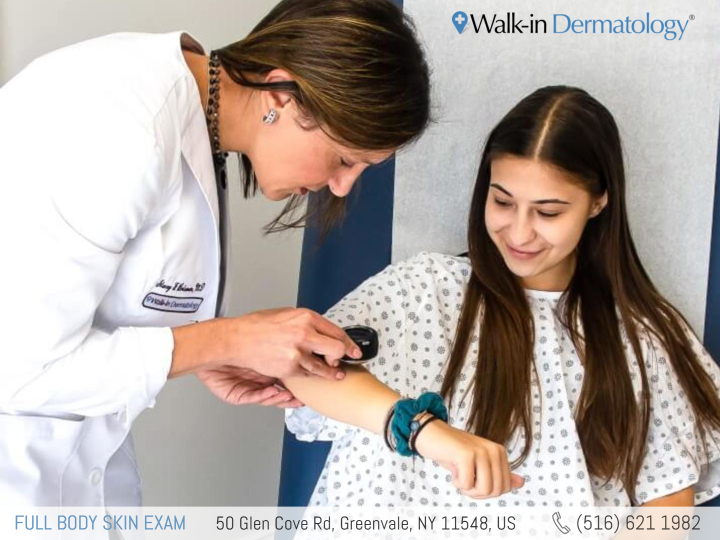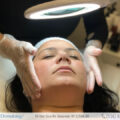Tues: 8:30am - 3:00pm
Wed: 12:00pm - 6:00pm
Thurs: 8:30am - 3:00pm
Fri: Closed
Sat: 8:30am - 12:30pm
Sun: Closed
Greenvale, NY 11548
What Do the Early Stages of Skin Cancer Look Like?


Early stage skin cancer may resemble a small spot or discolored blemish significantly smaller than the size of a fingernail. It may be reddish or brown, though sometimes white with flaking skin cells surrounded by a small blotch of darker skin.
If you have concerns about the recent appearance of unusual spots on your skin, schedule an appointment right away with a board-certified dermatologist.
Skin cancer is the abnormal growth of skin cells. Skin cancer develops when mutations occur in the DNA of skin cells. The mutations can quickly cause cells to grow out of control and turn into a mass of cancer cells, which then attack healthy cells.
The most common cause of skin cancer is prolonged overexposure to the sun, sometimes over a period of years, but skin cancer can also develop on areas of your skin not exposed to sunlight.
There are three main types of skin cancer: basal cell carcinoma, squamous cell carcinoma and melanoma. Other, rare forms of skin cancer also exist.
Skin cancer starts in the epidermis, which is the top layer of your skin. This top layer contains three main types of cells:
- Squamous cells that function as the inner lining of the skin.
- Basal cells, which produce new skin cells and exist below the squamous cells.
- Melanocytes, the cells that produce melanin, a pigment that gives skin its normal color. These are deeper in the epidermis. Melanocytes produce more pigmentation when you’re sunbathing to help protect the deeper layers of your skin. The result is a suntan and with severe exposure, a sunburn. Tanning is literally your body’s response to repairing sun-damaged skin.
Skin cancer is the most common form of cancer worldwide. In most cases it is caused by ultraviolet radiation from the sun or tanning beds. It is estimated that 1 in 5 Americans will develop skin cancer by the age of 70. Nearly 200,000 new cases of melanoma are diagnosed every year and more than 1 million Americans are living with melanoma, according to the American Academy of Dermatology.
Research has shown that patients with skin of color are less likely to survive melanoma. Late detection is one of the critical reasons for this higher mortality rate. On average, 2 people die of skin cancer in the United States every hour, reports the Skin Cancer Foundation.
Many of these deaths are unnecessary and preventable. With early detection and treatment, the 5-year survival rate from melanoma is close to 99 percent.
You can reduce your risk of skin cancer by limiting or avoiding exposure to ultraviolet (UV) radiation. Checking your skin for suspicious changes can help detect skin cancer at an early stage. Early detection of skin cancer gives you the greatest chance for successful skin cancer treatment.
Symptoms
Skin cancers grow primarily on areas of sun-exposed skin, including the scalp, face, lips, ears, neck, chest, arms and hands, and on the legs in women, according to the Mayo Clinic. It can also form on areas seldom exposed to the sun, including your palms, beneath your fingernails or toenails, and your genital area.
Skin cancer can attack people of all skin tones, including those with darker complexions. When melanoma occurs in people with dark skin tones, it’s more likely to occur in areas not normally exposed to the sun.
Basal Cell Carcinoma Signs
Basal cell carcinoma is usually caused by sun exposure, with bumps and lesions appearing on the neck or face.
Basal cell carcinoma may look like a pearly or waxy bump, a flat, flesh-colored or brown scar-like lesion or a sore that bleeds, scabs over, heals and returns.
Squamous Cell Carcinoma Signs
Squamous cell carcinoma most often occurs on sun-exposed areas of the body, including the face, ears and hands. It may appear as red nodules or flat lesions with a crusted surface.
Melanoma Signs
Melanoma is the most serious form of skin cancer and can develop anywhere on the body. In men, melanoma most often appears on the face or torso. In women, melanoma often develops on the lower legs. Melanoma can also develop on skin that hasn’t been exposed to the sun.
Melanoma can resemble a large, brown spot with darker speckles, moles that change in size, color or texture, painful lesions that itch or burn, or dark lesions on the palms, soles of the feet, fingertips or toes, or on mucous membranes lining your mouth, nose, vagina or anus. The vast majority of skin cancer deaths are caused by melanoma, the American Academy of Dermatology reports.
Less Common Types of Skin Cancer
Kaposi sarcoma
This is a rare form of skin cancer that develops in the skin’s blood vessels and causes red or purple patches. It often attacks people with weakened immune systems, such as individuals with AIDS, or in people taking medications that suppress their immune system, such as patients who’ve received organ transplants.
Merkel cell carcinoma
Merkel cell carcinoma causes firm, shiny nodules that occur on the surface or just beneath the skin and in hair follicles. Merkel cell carcinoma most often appears on the head, neck and torso.
Sebaceous gland carcinoma
This rare but aggressive cancer develops in the skin’s oil glands. Sebaceous gland carcinomas — which usually appear as hard, painless nodules — can develop anywhere, but frequently occur on the eyelid, where they can be mistaken for other eyelid problems.
When to See a Dermatologist
Plan an appointment with a dermatologist as soon as possible if you notice any changes to your skin that worry you. Not all skin changes are evidence of cancer. Your dermatologist will evaluate your skin changes to identify the cause and prepare a plan of treatment. Remember, early detection of skin cancer is the key to proper treatment and survival. Almost all skin cancers respond favorably to treatment – when detected early enough.
Skin Cancer Risk Factors
Some individuals are more prone to risk of skin cancer than others.
- Fair-skinned individuals. Although anyone can develop skin cancer, people who have less melanin in their skin are at higher risk because their bodies produce less protection against UV rays. People with red or blond hair and those who sunburn easily are more likely to develop skin cancer.
- If you have endured several severe sunburns in your life, including blistering or bleeding skin, you may be at higher risk of developing skin cancer. Research shows that even one blistering sunburn during childhood or adolescence can nearly double a person’s chance of developing melanoma during their lifetime.
- Too much sun/UV exposure. People who work outdoors, regularly use tanning beds or sunbathe frequently are more prone to skin cancer, especially those who aren’t using a sunscreen lotion.
- If you have many moles on your skin, you are at elevated risk of skin cancer. Moles that are larger and in irregular shapes are more likely to become cancerous.
- A family history of skin cancer.
- Precancerous skin lesions. These skin growths appear as rough, scaly patches on the face, head and hands.
- A weakened immune system.
- Radiation exposure. Radiation treatments for eczema, acne and other skin conditions can increase the risk of skin cancer, especially basal cell carcinoma.
- Previous melanoma. Individuals who have had more than one melanoma have an increased risk of again developing melanoma and other cancers, including breast, prostate and thyroid cancer.
Prevention
Follow these tips to reduce your risk of developing skin cancer.
- Stay out of the sun or at least minimize your exposure from 10 a.m. to 4 p.m. when the sun is at its peak.
- Wear sunscreen with an SPF of at least 30. Sunscreens cannot block all harmful UV radiation, especially the radiation that causes melanoma. But they do not work at all if they are not used.
- Wear protective clothing and a hat while outdoors.
- Wear sunglasses rated for UVA and UVB protection.
- Don’t use tanning beds.
- Tell your dermatologist about all medications you take. Some medicines can increase the skin’s sensitivity to sunlight, including varieties of antibiotics.
- Check your skin often for new or unusual growths.
Getting the Best Treatment
The good news is, we’ve taken the stress out of seeing a dermatologist. You don’t have to look far for excellent dermatology services. Best of all, there’s no waiting.
In many parts of New York and throughout the country, patients often wait weeks before they can see a board-certified dermatologist and receive a diagnosis, much less actual treatment.
That’s no longer necessary.
At Walk-in Dermatology, patients can see a board-certified dermatologist seven days a week. Our dermatologists will evaluate your skin and answer all your questions. We will work with you to set up a treatment plan to address your skin condition and get at the root of your issue – all convenient to your schedule.
No more waiting days or even weeks to see a dermatologist. Walk-in Dermatology is here for you. We are open and ready to help you regain healthy skin that positively glows with a youthful look.
Read more: Is Virtual Dermatology Effective?








